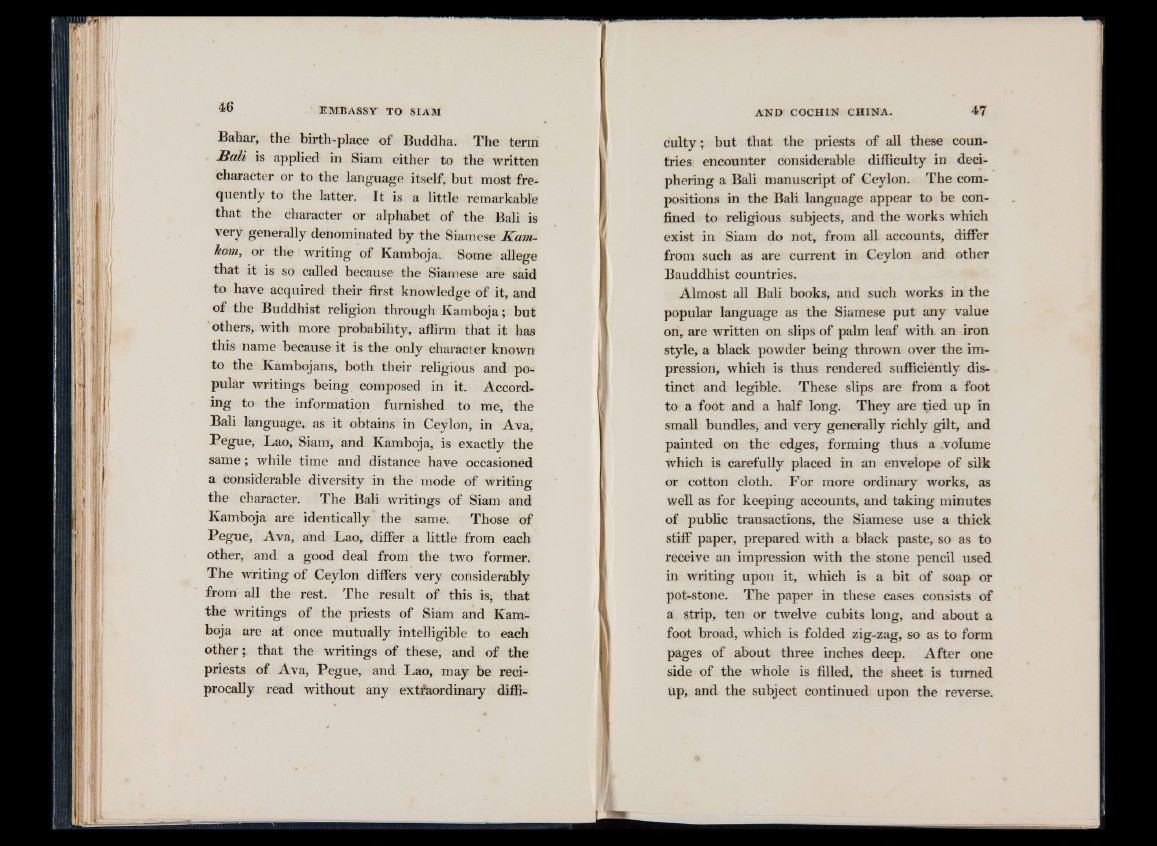
Bahar, the birth-place of Buddha. The term
B a li is applied in Siam either to the written
character or to the language itself, but most frequently
to the latter. It is a little remarkable
that the character or alphabet of the Bali is
very generally denominated by the Siamese Kam-
kom, or the writing of Kamboja. Some allege
that it is so called because the Siamese are said
to have acquired their first knowledge of it, and
of the Buddhist religion through Kamboja; but
others, with more probability, affirm that it has
this name because it is the only character known
to the Kambojans, both their religious and popular
writings being composed in it. According
to the information furnished to me, the
Bali language, as it obtains in Ceylon, in Ava,
Pegue, Lao, Siam, and Kamboja, is exactly the
same; while time and distance have occasioned
a considerable diversity in the mode of writing
the character. The Bali writings of Siam and
Kamboja are identically the same. Those of
Pegue, Ava, and Lao, differ a little from each
other, and a good deal from the two former.
The writing of Ceylon differs very considerably
from all the rest. The result of this is, that
the writings of the priests of Siam and Kamboja
are at once mutually intelligible to each
o th e r; that the writings of these, and of the
priests of Ava, Pegue, and Lao, may be reciprocally
read without any extraordinary difficu
lty ; but that the priests of all these countries
encounter considerable difficulty in deciphering
a Bali manuscript of Ceylon. The compositions
in the Bali language appear to be confined
to religious subjects, and the works which
exist in Siam do not, from all accounts, differ
from such as are current in Ceylon and other
Bauddhist countries.
Almost all Bali books, and such works in the
popular language as the Siamese put any value
on, are written on slips of palm leaf with an iron
style, a black powder being thrown over the impression,
which is thus rendered sufficiently distinct
and legible. These slips are from a foot
to a foot and a half long. They are tied up in
small bundles, and very generally richly gilt, and
painted on the edges, forming thus a volume
which is carefully placed in an envelope of silk
or cotton cloth. For more ordinary works, as
well as for keeping accounts, and taking minutes
of public transactions, the Siamese use a thick
stiff paper, prepared with a black paste, so as to
receive an impression with the stone pencil used
in writing upon it, which is a bit of soap or
pot-stone. The paper in these cases consists of
a strip, ten or twelve cubits long, and about a
foot broad, which is folded zig-zag, so as to form
pages of about three inches deep. After one
side of the whole is filled, the sheet is turned
up, and the subject continued upon the reverse.